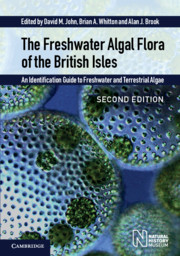 The Freshwater Algal Flora of the British Isles
The Freshwater Algal Flora of the British Isles Published online by Cambridge University Press: 12 January 2024
The euglenophytes or euglenoids contain about 54 freeliving genera. Most are colourless with heterotrophic nutrition, which is sometimes entirely osmotrophic, but in others also phagotrophic. However, about onethird of the genera are green and phototrophic and the majority of well known taxa in freshwater bodies are in fact green.
Currently about 900 species are known, of which just over 250 are colourless. These are usually placed in the phylum Euglenophyta by botanists, who recognize a single class having two (Bourrelly, 1985), three (Asaul, 1975) or six (Leedale, 1967) orders. Zoologists place the euglenophytes in the Protozoa and divide the Order Euglenida into five suborders (Lee et al., 1985; Leedale and Vickerman, 2000). Ultrastructural surveys of cell structure and subsequent molecular investigations have revealed a close relationship to two groups of flagellate protozoa, the trypanosomatids and diplonemids (Graham et al., 2009).
The euglenophytes are a diverse group of largely solitary and motile flagellates, although a few species form non-motile, branched colonies when in the actively growing condition and, more rarely, they are epiphytes (e.g. Colacium). The cells are typically obovoid, clavate, spindle or lance-shaped, cylindrical, and most are naked, with the plasma membrane surrounded by an often prominent pellicle with helical striations. Some forms are radially symmetrical (Gyropaigne kosmos), others are bilaterally symmetrical. The pellicle ranges from very flexible to semi- or completely rigid, and is usually striated. The striations are frequently twisted with respect to the longitudinal axis. There are muciferous bodies under the pellicle, which eject mucilage that forms layers around the cell.
The genera Trachelomonas, Strombomonas and Ascoglena are surrounded by an extracellular matrix, termed a lorica, which is often impregnated by deposits of ferric and/or manganic compounds (Leedale, 1975; Dunlap et al., 1983). At the anterior end a narrow canal leads into a flask-shaped reservoir, the anterior invagination. Adjacent to the enlarged basal portion are one or more active contractile vacuoles. In certain genera, there may be a rod-shaped organelle parallel to the reservoir. The canal is a continuation of the cytoplasmic membrane. At higher magnification, microtubules are often seen to be in association with the canal. The contractile vacuole may be almost spherical before discharge into the reservoir, and is frequently reported as being surrounded by several ‘subsidiary’ vacuoles.
The flagella are inserted in the latero-posterior wall of the reservoir.
To save this book to your Kindle, first ensure no-reply@cambridge.org is added to your Approved Personal Document E-mail List under your Personal Document Settings on the Manage Your Content and Devices page of your Amazon account. Then enter the ‘name’ part of your Kindle email address below. Find out more about saving to your Kindle.
Note you can select to save to either the @free.kindle.com or @kindle.com variations. ‘@free.kindle.com’ emails are free but can only be saved to your device when it is connected to wi-fi. ‘@kindle.com’ emails can be delivered even when you are not connected to wi-fi, but note that service fees apply.
Find out more about the Kindle Personal Document Service.
To save content items to your account, please confirm that you agree to abide by our usage policies. If this is the first time you use this feature, you will be asked to authorise Cambridge Core to connect with your account. Find out more about saving content to Dropbox.
To save content items to your account, please confirm that you agree to abide by our usage policies. If this is the first time you use this feature, you will be asked to authorise Cambridge Core to connect with your account. Find out more about saving content to Google Drive.